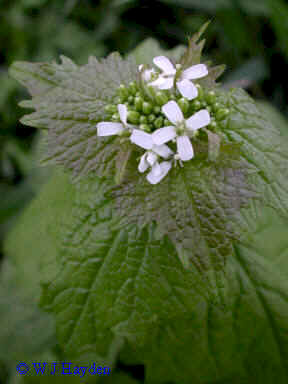| Alliaria petiolata | |
|
Garlic Mustard
|
|
| Origin Of Species | |
| Europe | |
| Physical Description | |
| Garlic mustard is a biennial herb that can grow anywhere from five to forty-six inches in height. The leaves are triangular and sharply toothed. Garlic mustard flowers are white, with four small petals, and form in clusters at the ends of stems. The seeds are black and found in rows within a long narrow capsule produced around May. Leaves and stems give off a characteristic garlic odor. | |
| Habitat And Distribution | |
| Garlic mustard grows in rich, moist forests, woodland edges, and stream banks. It also grows in disturbed areas such as roadsides and trail edges. It is prominent in the northeastern United States, as far south as North Carolina and west as Kansas and Nebraska. | |
| Location On Campus | |
| Garlic mustard is found within Westhampton Woods, along the upper reaches of Westhampton Lake, and surrounding the ravine parallel to College Road. It is abundant everywhere on the James River flood plain. | |
| Negative Impacts | |
| Garlic mustard is fairly tolerant of a wide range of temperatures and soil conditions, which allows it to quickly invade disturbed areas. It lacks natural predators, and produces seeds in plentiful quantities, quickly dominating groundcover while shading out and using the space, nutrients, and water available for other plants. | |
| VDCR Invasiveness Ranking | |
| Highly Invasive Species | |
